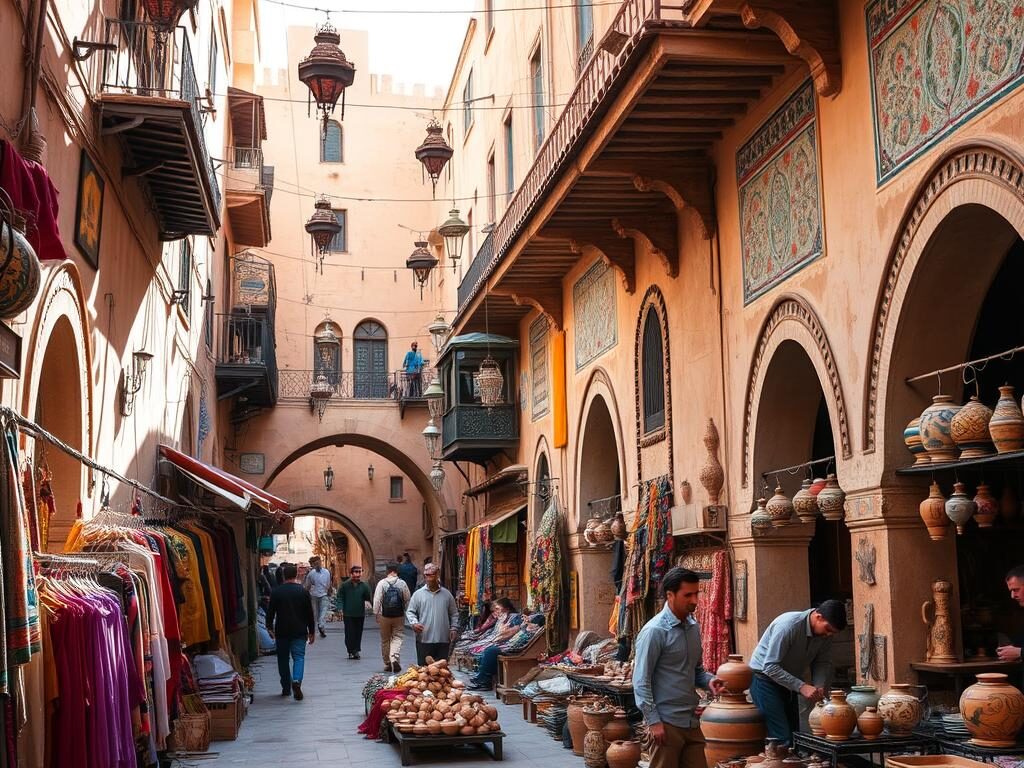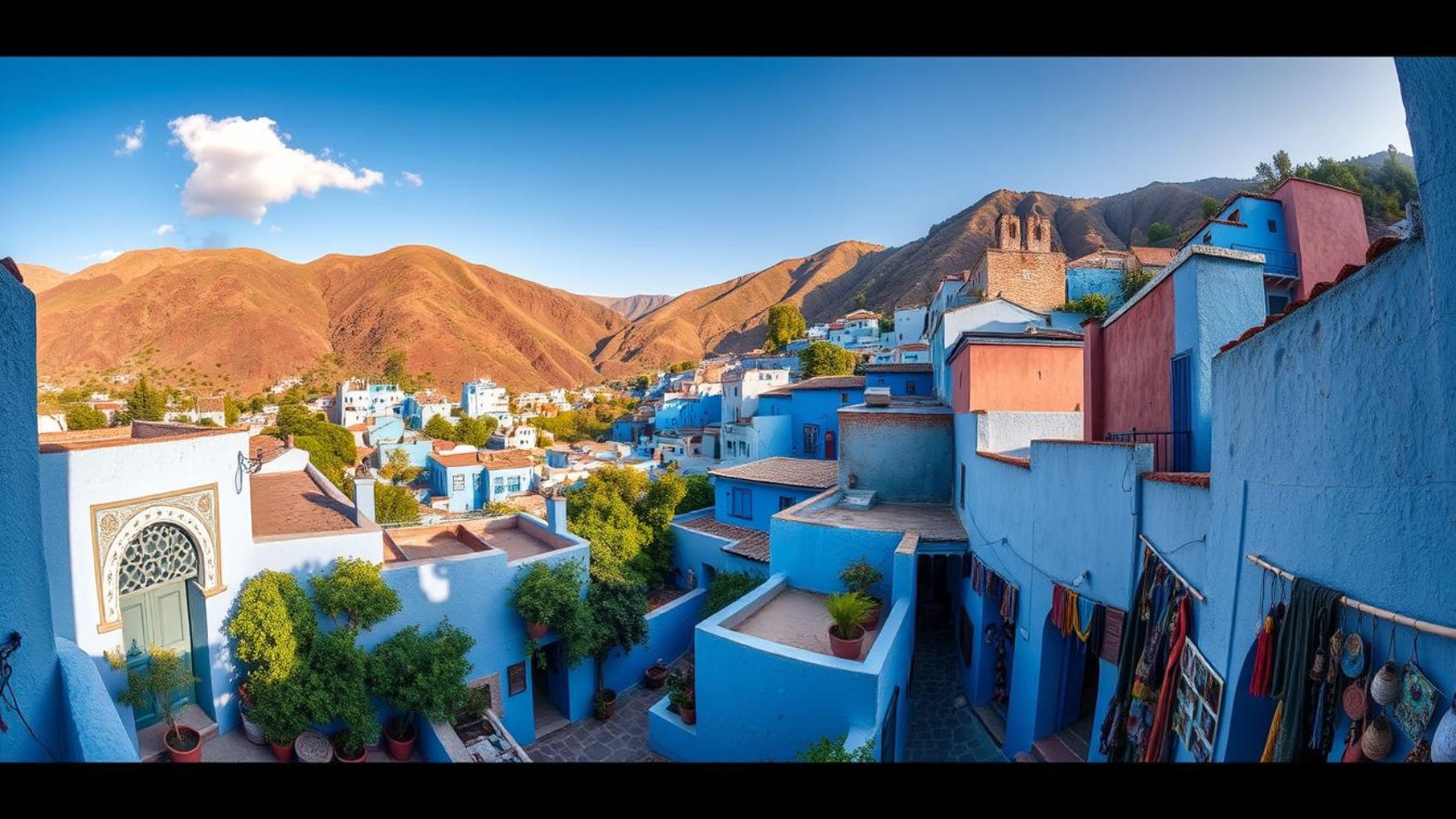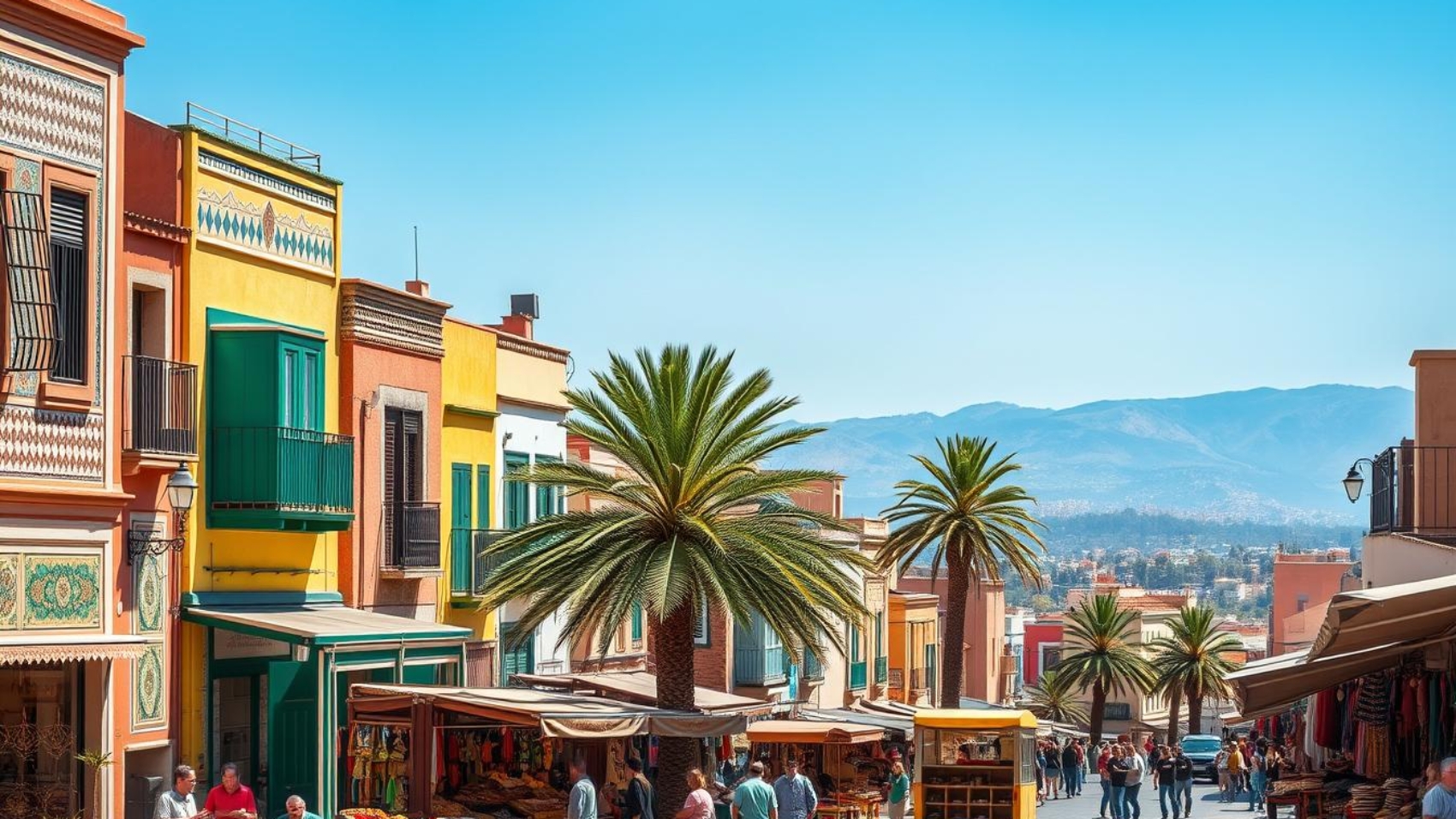The vibrant medinas of North Africa are gateways to a world of culture, history, and commerce. These historic areas are surrounded by ancient walls. They offer a glimpse into urban life that has lasted for centuries.
Visitors are captivated by the narrow alleys filled with the scent of spices. They also enjoy the colorful handicrafts and the sound of traditional music. Places like Marrakech, Algiers, and Tunis are filled with these wonders.
Each medina has its own story, blending the old with the new. Whether you’re exploring the busy souks or admiring the architecture, the experience is unforgettable. Let’s explore the stunning medinas of North Africa together, where history meets adventure at every turn.
What are Medinas?
Medinas are the historical centers of cities in North Africa. They have narrow, winding streets and intricate designs. These features create a unique atmosphere that shows the North African culture.
These areas are cultural hubs where locals and tourists do various activities. The word ‘medina’ comes from Arabic, meaning ‘city.’
Medinas are filled with bustling markets, courtyards, mosques, and homes. They showcase Islamic architecture influenced by many cultures over time.
Visiting a medina lets you see the mix of tradition and modernity in North African culture. It’s not just about history. It’s also about seeing how people live in these lively places.
Exploring the Historic Medinas of North Africa
Historic medinas in North Africa are cultural treasures. They invite visitors to uncover their charm and heritage. Places like Marrakech, Fes, and Tunis are among the most fascinating landmarks. Each medina has its own unique features to explore.
In Fes, you can wander through ancient alleys. It’s one of the oldest medinas in the world. The University of Al Quaraouiyine, a renowned institution, adds to its charm. It showcases centuries of learning and tradition.
Marrakech is known for its lively Jemaa el-Fnaa square. Here, street performers, food vendors, and artisans come together. It’s a thrilling way to see how locals live and work.
Guided walking tours are a great way to explore these medinas. They let you dive into the stories and traditions of these places. You’ll see artisan crafts and ancient buildings, gaining insight into North Africa’s rich history.
Must-Visit Medina Attractions
Exploring the medina attractions takes you deep into North Africa’s rich culture and history. This area is famous for its iconic landmarks. Each one has its own story to tell.
Visitors can dive into a world of fascinating architecture, traditional markets, and lively local life. It’s an experience unlike any other.
Iconic Landmarks in the Medinas
Medinas are home to many iconic landmarks that you can’t miss. The Koutoubia Mosque in Marrakech is a must-see with its stunning minaret. It’s a symbol of the city.
The Bou Inania Madrasa in Fes is known for its intricate tilework and unique architecture. It gives a glimpse into the area’s educational past. Other sites include historic palaces and ancient city gates. Each one adds to North Africa’s cultural story.
Bazaars and Souks: Shopping Experiences
Bazaars and souks are the heart of the medinas. They offer more than just shopping; they give a glimpse into local life. Walking through the streets, you’ll be surrounded by colors and smells.
You can find everything from spices and textiles to ceramics and handmade crafts. These markets are not just for shopping. They are key to the medina’s economy and social life. They bring locals and tourists together, sharing in the joy of culture and commerce.
The Rich History of North Africa’s Medinas
The medinas of North Africa have a rich history. They were shaped by the Berbers, Arabs, and French colonizers. This mix of cultures makes these areas truly unique. The medinas started as important trade routes in the ninth century.
Over time, many events have shaped the medinas. Dynasties were formed, and trade became key. Now, they are like living museums, showing the stories of their people. The North African culture in the medinas is something to explore and enjoy.
- Berber influences in architecture and crafts
- Arab contributions to urban planning and trade practices
- French colonial impact on infrastructure and city layout
Walking through the medinas, you see history and culture come together. The narrow alleys and lively squares tell stories of the past. They show how cultures have connected over the centuries, creating a legacy that lives on today.
Unique Medina Architecture: A Blend of Cultures
Medina architecture is a beautiful mix of styles. Each style tells a story of history and cultural exchange. You can see how Islamic, Moorish, and Andalusian designs come together in a unique way. This blend offers a deep dive into the art and dedication of local artisans.
Architectural Styles to Look For
Exploring the medinas reveals many architectural wonders. You’ll find everything from beautifully decorated riads to stunning mosques. Each one shows the rich history of the region. Here are some key features to look out for:
- Ornate Wooden Doors: These doors are adorned with detailed carvings and designs, inviting you to explore.
- Decorative Tile Work: Mosaic tiles add a splash of color, showing off the artistry and cultural heritage.
- Beautifully Designed Fountains: Many plazas feature fountains, which serve as meeting spots and showcase artistic talent.
- Iconic Medina Gates: The gates are a mix of function and art, often becoming key landmarks.
By noticing these features, you learn about the lasting impact of craftsmanship and cultural identity in the medinas. Enjoy the architectural variety as you explore these historic areas.
Cultural Significance of Medinas in North Africa
Medinas are at the heart of North African cities, showing their deep cultural value. They are more than places; they are community centers where traditions grow and people connect.
Cultural events and rituals take place in medinas. These events help people celebrate their heritage together. Traditional dances and music fill the air, showing the community’s spirit.
Medinas are also key for trade and commerce. Local artists and sellers show off their work, creating a special market. This supports local businesses and strengthens community ties, as people rely on each other for work.
Exploring medinas reveals their cultural importance. Visitors see the traditions that shape daily life, giving a peek into North Africa’s lasting values.

A Guide to Medina Tours: What to Expect
Exploring the enchanting medinas of North Africa is a unique journey. You can choose guided tours or go for self-guided tours. Each option has its own benefits that make your trip more enjoyable.
Guided vs. Self-Guided Tours
Guided tours let you learn from locals who share history and culture. They show you important landmarks and tell interesting stories. Self-guided tours, however, let you explore at your own pace. You can plan your own route and discover hidden spots.
For self-guided tours, it’s important to do your research. Good planning helps you find the best places and enjoy your trip fully.
Essential Tips for Tourists
To make the most of your medina tours, follow these travel tips:
- Stay aware of your surroundings to navigate the bustling streets safely.
- Keep an open mind when interacting with locals; cultural exchanges enrich the experience.
- Learn a few phrases in Arabic or French, as this boosts communication and fosters goodwill.
- Dress appropriately for the medina, respecting local customs while staying comfortable.
- Familiarize yourself with shopping etiquette, as bargaining is often expected in markets.
Local Cuisine: Tasting the Flavors of the Medinas
Exploring the diverse flavors of medina cuisine is a highlight for many visitors. The culinary offerings found here showcase unique traditional dishes. These dishes reflect the rich culture and history of North Africa. Each dish offers a delightful experience, drawing from the area’s fresh ingredients and centuries-old cooking techniques.
Traditional Dishes to Try
When indulging in the local fare, some traditional dishes stand out. Consider trying:
- Tagine – A slow-cooked stew featuring a variety of meats and vegetables.
- Couscous – Often served as a side, this fluffy grain pairs beautifully with stews.
- Pastilla – A savory pie that uniquely blends sweet and savory, typically made with pigeon or chicken.
Don’t overlook the importance of spices; saffron and harissa are staples. They add depth to the dishes and are readily available in the bustling food stalls.
Recommended Restaurants and Food Stalls
The medinas are home to numerous food stalls and restaurants. Here, the flavors of the region come to life. For memorable meals, consider visiting:
- Jemaa el-Fnaa – A famous square filled with vibrant food stalls offering everything from grilled meats to sweet pastries.
- Café de France – A popular eatery known for its traditional Moroccan dishes.
- Le Tobsil – A charming restaurant that provides an authentic dining experience, featuring multi-course meals.
Exploring these vibrant eateries allows visitors to savor the heart of medina cuisine. This makes any trip unforgettable.
Medina Travel Guide: Navigating the Alleys
Exploring the narrow alleys of a medina is an exciting adventure. It’s filled with sights, sounds, and scents. A good travel guide suggests using a map or a local guide. Knowing the layout of these streets will make your trip better.
Learn about key landmarks. Knowing these places helps you avoid getting lost. Keep a list of landmarks in mind. This helps you find your way back if needed.
Local transport is key to your journey. Knowing about taxis and buses helps you move around easily. Reliable transport saves time and lets you explore more without getting tired.
Understand the medina’s flow. Knowing peak hours and quiet times makes your visit better. With these tips, you’ll enjoy navigating the medina’s alleys.
Vibrant Festivals in the Medinas
Medina festivals show the rich culture of North Africa. These events highlight the traditions that live in the historic streets. Festivals like the Marrakech Popular Arts Festival and the Fes Festival of World Sacred Music showcase local talent.
The festivals are lively, filled with traditional music and colorful costumes. Visitors can dive into the culture, learning about traditions from around the world. Interacting with locals makes these celebrations even more special.
At these events, you can try traditional foods and watch amazing performances. The close setting of the medinas makes these experiences unique. They are moments you won’t forget.
Safety Tips for Exploring Medinas
When you explore the lively medinas of North Africa, safety is key. Knowing the local customs helps you feel more at ease. It also leads to better interactions with the people there.
Make sure to keep your belongings safe. Use a cross-body bag and avoid wearing anything too flashy. Stay on busy streets where there are lots of people. This makes you feel safer as you take in the sights and sounds.
Talking to locals with respect can make your trip better. They often know the safest paths and hidden spots that tourists miss. Listening to their advice not only keeps you safe but also makes your journey more interesting.
Following these safety tips will help you have a safer and more enjoyable time in the amazing medinas of North Africa.
Best Times to Visit the Medinas
Timing is key for a great trip to North Africa’s medinas. The best months are March to May and September to November. These times have mild weather, perfect for outdoor fun.
Visitors can enjoy local events that show off the area’s culture and community. Summer, however, is too hot for many to venture out. This means fewer chances to meet locals and other tourists.
Each season brings its own charm and cultural experiences. For example, Ramadan in the medinas is a time of special food and celebrations. Fall harvest festivals offer a glimpse into local farming traditions.
Knowing when to visit helps you connect more with the place and its people. Plan your trip to see the medinas in all their glory.
Conclusion
The vibrant medinas of North Africa are like windows into a world full of history and culture. They attract travelers from everywhere. These lively marketplaces and complex alleys show off a mix of old traditions and modern life.
Every trip to these medinas is more than a visit. It’s a chance to explore and learn about this special place. You get to see the rich traditions and the blend of old and new.
Walking through the streets, you find many exciting things. There are markets with unique goods, tasty foods, and amazing buildings. Talking to local artists and trying different foods lets you see the local way of life.
It also helps keep these special places alive for the future. It’s as important as the journey itself.
Exploring the medinas of North Africa is a memorable adventure. It stays with you long after you leave. Take the chance to dive into this amazing world and help keep its traditions alive.
FAQ
What are the most famous medinas to visit in North Africa?
The Medina of Marrakech is famous for its lively souks. The Medina of Fes is known for its medieval architecture and the historic University of al-Qarawiyyin. The Medina of Tunis is also popular, blending traditional and French colonial styles.
How can I best explore the medinas?
Guided tours offer insights from locals. Self-guided tours let you explore at your own pace. Both methods are good, but a travel guide can help uncover hidden gems.
What should I wear when visiting the medinas?
Wear comfortable, respectful clothing. Bring light layers for temperature changes. Sturdy shoes are essential for the uneven streets.
Are there any safety concerns when exploring the medinas?
Medinas are generally safe. Stay alert, keep valuables secure, and avoid empty areas. Respectful interactions with locals can also keep you safe.
What types of food can I try in the medinas?
Try traditional dishes like tagine, couscous, and harissa. Food stalls and restaurants throughout the medinas offer these flavors and more.
What is the significance of festivals in the medinas?
Festivals showcase local culture through music, dance, and crafts. Events like the Marrakech Popular Arts Festival let visitors experience traditions and connect with the community.
When is the best time to visit the medinas?
Spring (March to May) and fall (September to November) are the best times. Summer is too hot, but seasonal events offer unique cultural experiences.
What architectural styles are typical in the medinas?
Medina architecture combines Islamic, Moorish, and Andalusian styles. Look for tile work, ornate doors, and riads that showcase the region’s history and craftsmanship.
How do medinas contribute to local economies?
Medinas are key to local economies, offering traditional goods and supporting artisans and small businesses. The souks attract locals and tourists, boosting trade and livelihoods.




